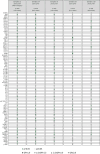Inflammatory plasma protein levels are elevated years before sarcoidosis diagnosis: a nested case-control study in Sweden
- PMID: 39326919
- PMCID: PMC11684420
- DOI: 10.1183/13993003.00277-2024
Inflammatory plasma protein levels are elevated years before sarcoidosis diagnosis: a nested case-control study in Sweden
Abstract
Background: Sarcoidosis is an immune-mediated inflammatory disease whose natural development is not well understood. We aimed to determine if inflammatory plasma protein levels are elevated before sarcoidosis diagnosis compared to controls. Furthermore, we investigated which proteins are increased and how long before diagnosis they are increased.
Methods: Cases with sarcoidosis and controls matched 2:1 on sex, birthdate, subcohort and sample date were identified in the Northern Sweden Health and Disease Study to perform a nested case-control study. Cases were validated and included if they provided one or more plasma samples at least 2 years before sarcoidosis diagnosis. Plasma protein levels were measured using the Olink Inflammation panel and expressed in normalised protein expression values. Unconditional logistic regression models adjusted for age, sex, subcohort and time since sampling were used to estimate log odds ratios with 95% confidence intervals for each protein overall and by time to diagnosis. p-values were adjusted for multiple comparisons using the Benjamini-Hochberg method.
Results: We included 152 cases and 341 controls. Mean time between sample and sarcoidosis diagnosis was 13.4 years. 44 proteins were significantly elevated prior to sarcoidosis compared to controls in multivariable-adjusted analyses. The 10 proteins with the lowest p-values were CCL-3, CCL-19, cub domain-containing protein 1, CXCL9, CXCL10, interferon-γ, interleukin-12B, monocyte chemoattractant protein-3, tumour necrosis factor (TNF), and TNF receptor superfamily 9. Fewer proteins were associated with sarcoidosis in samples taken longer before diagnosis. Restricting to samples taken ≥10 years prior to sarcoidosis diagnosis, 27 proteins remained statistically significant.
Conclusion: Several inflammatory proteins were elevated in plasma many years before sarcoidosis onset compared to controls, revealing a pre-clinical phase characterised by inflammation.
Copyright ©The authors 2024.
Conflict of interest statement
Conflict of interest: E.V. Arkema received support for this work from the Swedish Research Council, the Strategic Research Area in Epidemiology (SfoEpi) at Karolinska Institutet and the Sven and Ebba Hagberg Prize; and received an honorarium for grant review from the Milken Institute. The remaining authors have no potential conflicts of interest to disclose.
Figures







Comment in
-
More evidence that sarcoidosis is a host disease, and the identity of the aetiological triggers is irrelevant.Eur Respir J. 2024 Dec 19;64(6):2402051. doi: 10.1183/13993003.02051-2024. Print 2024 Dec. Eur Respir J. 2024. PMID: 39736109 No abstract available.
-
Comment on: Inflammatory plasma protein levels are elevated years before sarcoidosis diagnosis: a nested case-control study in Sweden.Eur Respir J. 2025 Jan 2;65(1):2402027. doi: 10.1183/13993003.02027-2024. Print 2025 Jan. Eur Respir J. 2025. PMID: 39746766 No abstract available.
References
MeSH terms
Substances
LinkOut - more resources
Full Text Sources
Medical
Research Materials
